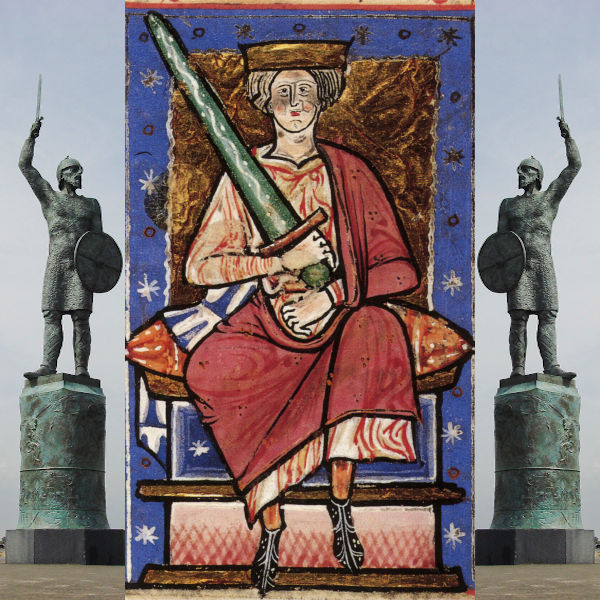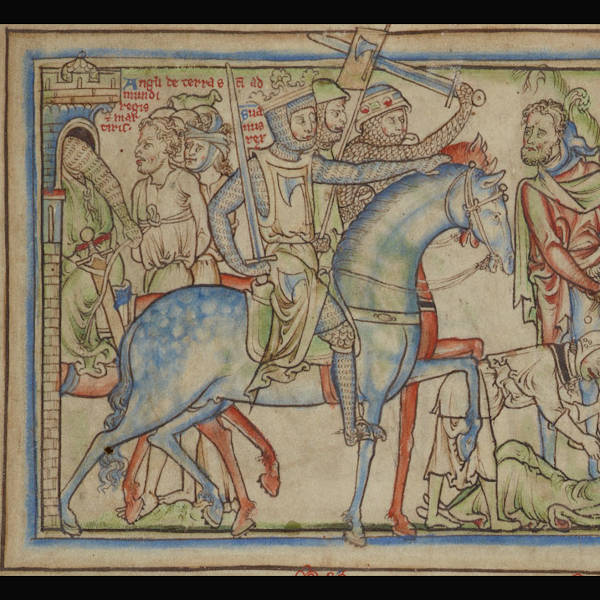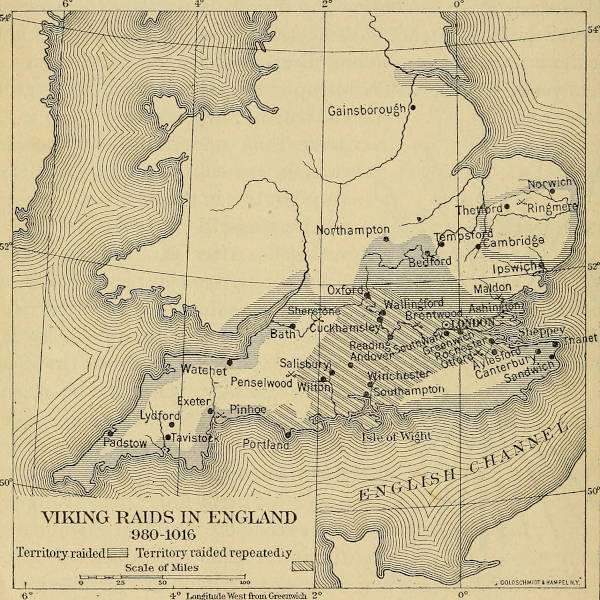DNA spotlight
St. Brice's Day Massacre

Aethelred II, known later as the Unready, was King of the English from 978 to 1013 and again from 1014 until his death. He came to the throne at the age of 12 after his half brother was murdered. At the start of his reign, Danish raids on English territory began in earnest. Aethelred defended his country by a diplomatic alliance with the duke of Normandy. The Battle of Maldon on 11. August 991 AD involved 2,000-4,000 fighting Viking men led by Olaf Tryggvason against the Anglo-Saxon leader Byrhtnoth who was the Ealdorman of Essex. This ended in defeat for the Anglo-Saxons and King Aethelred was forced to pay tribute, also known as Danegeld, to the Danish king. This payment of 10,000 Roman pounds of silver was the first example of Danegeld in England - a pattern which would follow. The Danish army continued ravaging the English coast until a Danegeld of 22,000 pounds of gold and silver was paid - at which point Olaf Tryggvason promised to never return. Viking attacks only grew worse - Danish raids would follow leading to an even larger Danegeld payment of 24,000 pounds for peace in the Spring of 1002 AD.

The same year, Aethelred married Lady Emma, the sister of Duke Richard II of Normandy in hopes of a stronger diplomatic alliance. On St. Brice's Day, 13. November 1002, the confident yet paranoid King ordered the killing of all Danes living on border towns such as Oxford. Aethelred described this massacre in his own words: ... a decree was sent out by me with the counsel of my leading men and magnates, to the effect that all the Danes who had sprung up in this island, sprouting like cockle amongst the wheat, were to be destroyed by a more just extermination, and thus this decree was to be put into effect even as far as death, those Danes who dwelt in the afore-mentioned town, striving to escape death, entered this sanctuary of Christ, having broken by force the doors and bolts, and resolved to make refuge and defence for themselves therein against the people of the town and the subrubs; but when all the people in pursuit strove, forced by necessitym to drive them out, and could not, they set fire to the planks and burnt, as it seems, this church with its ornaments and its books.

The skeletons of 34 to 38 fit, fighting-aged males with large and extremely robust physiques were found under St. John's College, Oxford in 2008 who are thought to be these Vikings killed in St. Frideswide's Church. The skeleton bone collagen showed they had eaten more fish and shellfish than the typical Anglo-Saxon locals, and the bones showed numerous older battle scars indicating they were experienced professional warriors. Twenty of the bodies bore traumatic punctures in their verebrae, pelvic bones or skulls. Some victims had serious burns ot their heads, backs, pelvic regions and arms - others showed puncture wounds from multiple points of attack including blade and puncture wounds to the back of the head. Among those thought to have been killed is Gunhilde, who was the sister of Sweyn Forkbeard, King of Denmark. Her remains have not yet been discovered. Her husband Pallig Tokesen, the Danish Ealdorman of Devonshire was also killed in the massacre. This triggered King Sweyn to head to Normandy, make a treaty with a Viking descendant of Rollo, and commence with a series of campaigns to invade England.

Sweyn launched an invasion in 1013 intending to crown himself king of England, during which he demonstrated his prowess as a general more than any other Viking of his generation. By the end of the year, English resistance collapsed and Aethelred was forced into exile in Normandy. However on 3. February 1014 Sweyn died suddenly. His crews of Danish ships immediately swore loyalty to his son Cnut the Great. The Norwegian Olaf Haraldsson worked with Aethelred to retake London and other parts of the country. Cnut and his army withdrew and in April 1014 and Aethelred got his revenge against the Danes. Not long after Aethelred's own death two years later, Cnut defeated Aethelred's son Edmund Ironside in a decisive battle and just a few months later Cnut became king of all of England. A few years later he was also crowned King of Denmark, and later also became King of Norway, and parts of Sweden. He was a strong and effective king, introducing Danish customs to England and also English influence back to Denmark. Cnut appointed several Englishmen as bishops in Denmark and he married Emma of Normandy (the widow of Aethelred). She bore Cnut a son, Harthacnut, who was succeeded by her own son with Aethelred - Edward II, known as the Confessor.
Sample: Danish Viking Clan St. Brice Massacre Oxford
- Sample ID: VK144
- Year: 1002 AD
- Sex: Male
- Location: 51.7558,-1.2605
Sample: Viking St. Brice Massacre Oxford
- Sample ID: V1P
- Year: 1002 AD
- Sex: Male
- Location: 51.7558,-1.2605
Sample: Viking St. Brice Massacre Oxford
- Sample ID: V2P
- Year: 1002 AD
- Sex: Male
- Location: 51.7558,-1.2605
Sample: Viking St. Brice Massacre Oxford
- Sample ID: V3P
- Year: 1002 AD
- Sex: Male
- Location: 51.7558,-1.2605
Sample: Viking St. Brice Massacre Oxford
- Sample ID: V4P
- Year: 1002 AD
- Sex: Male
- Location: 51.7558,-1.2605
Sample: Viking St. Brice Massacre Oxford
- Sample ID: V5P
- Year: 1002 AD
- Sex: Male
- Location: 51.7558,-1.2605
Sample: Viking St. Brice Massacre Oxford
- Sample ID: V6P
- Year: 1002 AD
- Sex: Male
- Location: 51.7558,-1.2605
Sample: Viking St. Brice Massacre Oxford
- Sample ID: V7P
- Year: 1002 AD
- Sex: Male
- Location: 51.7558,-1.2605
Sample: Viking St. Brice Massacre Oxford
- Sample ID: V8P
- Year: 1002 AD
- Sex: Male
- Location: 51.7558,-1.2605
Sample: Viking St. Brice Massacre Oxford
- Sample ID: V9P
- Year: 1002 AD
- Sex: Male
- Location: 51.7558,-1.2605
Sample: Viking St. Brice Massacre Oxford
- Sample ID: V10P
- Year: 1002 AD
- Sex: Male
- Location: 51.7558,-1.2605
Sample: Viking St. Brice Massacre Oxford
- Sample ID: V11P
- Year: 1002 AD
- Sex: Male
- Location: 51.7558,-1.2605
Sample: Viking St. Brice Massacre Oxford
- Sample ID: VK168
- Year: 1002 AD
- Sex: Male
- Location: 51.7558,-1.2605
Sample: Viking St. Brice Massacre Oxford
- Sample ID: VK163
- Year: 1002 AD
- Sex: Male
- Location: 51.7558,-1.2605
Sample: Viking St. Brice Massacre Oxford
- Sample ID: VK164
- Year: 1002 AD
- Sex: Male
- Location: 51.7558,-1.2605
Sample: Viking St. Brice Massacre Oxford
- Sample ID: VK167
- Year: 1002 AD
- Sex: Male
- Location: 51.7558,-1.2605
Sample: Viking St. Brice Massacre Oxford
- Sample ID: VK143
- Year: 1002 AD
- Sex: Male
- Location: 51.7558,-1.2605
Sample: Viking St. Brice Massacre Oxford
- Sample ID: VK145
- Year: 1002 AD
- Sex: Male
- Location: 51.7558,-1.2605
Sample: Viking St. Brice Massacre Oxford
- Sample ID: VK146
- Year: 1002 AD
- Sex: Male
- Location: 51.7558,-1.2605
Sample: Viking St. Brice Massacre Oxford
- Sample ID: VK147
- Year: 1002 AD
- Sex: Male
- Location: 51.7558,-1.2605
Sample: Viking St. Brice Massacre Oxford
- Sample ID: VK148
- Year: 1002 AD
- Sex: Male
- Location: 51.7558,-1.2605
Sample: Viking St. Brice Massacre Oxford
- Sample ID: VK149
- Year: 1002 AD
- Sex: Male
- Location: 51.7558,-1.2605
Sample: Viking St. Brice Massacre Oxford
- Sample ID: VK150
- Year: 1002 AD
- Sex: Male
- Location: 51.7558,-1.2605
